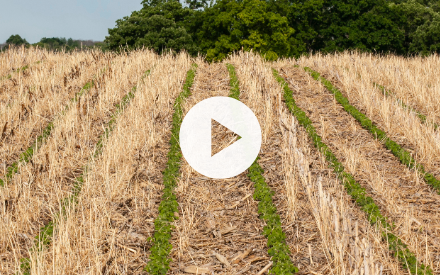What is DON?
DON (deoxynivalenol or vomitoxin) is a mycotoxin produced by the fungus responsible for Fusarium Head Blight (FHB), a common and economically important disease in small grains. DON is a problem because it is toxic to humans and animals. Grain grown on-farm and fed to livestock should be managed properly to avoid negative effects.
Identifying Fusarium Head Blight in the Field
Unfortunately, identifying FHB in the field is not a good way to gauge the level of DON in the grain at harvest. There is very little correlation between visual FHB incidence and DON concentrations in grain. However, identifying fields that have higher levels of FHB may allow for a tailored harvest strategy that reduces the number of DON kernels harvested.
FHB can be identified in the field 2-3 weeks after flowering. Bleached kernels on part or all the seed head indicate infection. Other signs such as pink/orange spore masses, black fruiting bodies, and shriveled kernels are common symptoms of FHB.

Orange spore masses from FHB

Bleached kernels from FHB
Harvest Considerations for Wheat with FHB
Shriveled, lightweight kernels, often called “tombstone kernels”, carry high amounts of mycotoxins, including DON. In-season scouting may help identify fields with high levels of tombstone kernels. During harvest, the combine should then be set with a higher fan speed in these fields to maximize the percentage of those kernels blown out the back with the chaff. Checking the grain sample often during harvest is a good way to verify you are eliminating these tombstone kernels from the final product.
Storage and Timing
Although blowing the worst kernels out of the combine will help, it will not prevent DON from being present in the grain. Grain from fields with higher levels of FHB infection should be stored separately from other healthier fields as the fungal pathogen can persist in the bin and continue to infect otherwise healthy kernels. Avoid this by ensuring grain is dried to 13% moisture before storage.
All grain from heavily infected fields should be tested separately; however, grain from healthy fields should be tested as well. Test results should be used by a nutritionist to create a feeding recommendation. The grain with the highest DON levels should be used first, if it is still within a safe range, to reduce DON spread within the bin.
DON Can Also Be Found in Straw
Work at the University of Illinois demonstrated a high correlation between DON concentration in the grain and DON concentration in the straw. DON is very water soluble, thus when it rains near harvest, DON can be leached from the grain head to the straw. Fields with high concentrations of DON in the grain should also have the straw tested for DON to be sure the DON levels don’t exceed safe limits, especially if the straw is used in the total feed ration.
Feeding Recommendation in Cattle
Rations built for dairy animals should contain no more than 0.5 to 1.0 ppm DON while feedlot beef should get no more than 10 ppm in their total diet. Work with your nutritionist to create a feeding plan that meets these criteria to avoid any health or production concerns. If DON is consumed past safe levels, cattle can recover fully. However, early detection and monitoring animal health is the best way to prevent serious illness and potential death losses.
Monitoring Animal Health
Symptoms of overconsumption of DON in animals include vomiting, feed refusal, decreased milk production, diarrhea, staggers, skin irritation, and immunosuppression. This can result in decreased feed conversion, performance, and reproductive health. If you suspect DON or any other mycotoxins in your feed, pull your animals off the contaminated feed immediately.
Take-Home Points
- Scout fields pre-harvest to gauge FHB levels
- Adjust combine settings to remove “tombstone kernels”
- Store and test grain with higher incidence of FHB separately, if possible
- Consult a nutritionist to design rations based on lab results
- Monitor animal health to avoid mycotoxin-related production loss
Resources
Mycotoxin Guidelines and Dietary Limits Summarized by Dr. John Goeser, PAS & Dipl. ACAN Revised January, 2015: 2016.02.16-RRL-Mycotoxin_Guidelines.pdf (badgercropdoc.com)
Gashew, M. (2016, January). Review on mycotoxins in feeds: Implications to livestock and human health. J Agric Res, 5(3): 137-144 Mostrom, M. (2021, November). Overview of mycotoxicoses in animals. Merck Veterinary Manual. https://www.merckvetmanual.com/toxicology/mycotoxicoses/overview-of-mycotoxicoses-in-animals

 ▶ Watch: Focus on Forage Cover Crops
▶ Watch: Focus on Forage Cover Crops ▶ Watch: Focus on Alfalfa Companions
▶ Watch: Focus on Alfalfa Companions Fall Forage Rye for Dairy Heifers and Dry Cows
Fall Forage Rye for Dairy Heifers and Dry Cows ▶ AI in Agriculture
▶ AI in Agriculture


